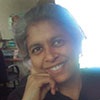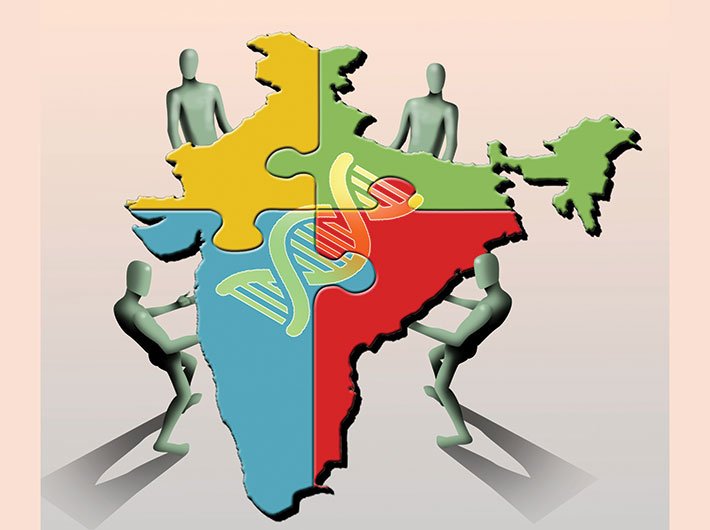Today’s Indian population derives from four groups, not two as supposed earlier, finds a new genetic study that uncovers a layer of diversity that is India
Going back in time by thousands of years holding on to the invisible strings of one’s DNA is a miracle of science. But geneticists studying the Indian genes are unable to trace the divisions that have marked India for a long time – first due to caste, and then or simultaneously due to religion. The Indian gene is, in fact, an example of a humanity that was less rigid about its divisions than it is now. This is evident in the extent of inter-mixing between various lineages for many centuries till 1,500 to 2,000 years ago.
Even the last mentioned period is a revelation. According to a new study carried out by Analabha Basu, Neeta Sarkar-Roya, and Partha P Majumder – from the National Institute of Biomedical Genomics (NIBMG) at Kalyani, West Bengal, and Human Genetics Unit at the Indian Statistical Institute (ISI), in Kolkata – published last month in the Proceedings of the National Academy of Sciences (PNAS), the Indian genome is a result of admixture that went on for a long time till it gradually came to about 1,500 years ago. It also says that the gene shows evidence of ancestries numbering not just two, as believed by earlier studies, but four and these are all mixed up in varying proportions in the samples examined.
While earlier studies had traced Indian lineages to Ancestral North Indian (ANI) and Ancestral South Indian (ASI), the new study adds two more – Ancestral Austro-Asiatic and Ancestral Tibeto-Burman.
There is no mention of either Aryans or Dravidians anywhere in the study. The complexity of the gene does not allow such simple classifications either. In fact, the study’s lead author Basu, refuses to use these terms saying he does not agree with their definitions.
Asked if Aryans are not the same as ANI, as they are referred to as speakers of the Indo-European family of languages, he says that that might be so but they were too mixed up with ASI to be distinguished. Geographical proximity does not necessarily mirror genetic proximity in India, while this is usually the rule in places like Europe, says Basu.
“Take the example of the Brahmins in Bengal and Tamil Nadu. The Iyers of Tamil Nadu live near the Nilgiri hills but they have more in common with the Brahmins of Bengal than with the Paniya and Irula tribals who live in the hills,” says Basu. Similarly, the Khatris of Punjab and Himachal were found to be similar to the central south Asians (Pathans and Sindhis of Asian Pakistan), he adds.
Dr K Thangaraj from the Centre for Cellular and Molecular Biology (CCMB), Hyderabad, who was part of the two earlier studies carried out in 2009 and 2013 which found two main ancestries, recalls how his study had revealed affinity between Kashmiri Pandits, Pathans and Sindhis of Pakistan.
“The gene is a great unifier,” he says. “It does not go by the boundaries which are created artificially later due to political or religious differences,’’ he adds.
Going from race to religion, caste and nations, the latest study also raises the question as to when one religion stopped talking to the other, since when did one caste stop mingling with the other, or one nationality stop holding hands with another as an inter-mixable family.
Going by the history textbooks, rigidity in the caste system began somewhere in the later Vedic period or about 2,500 years ago, i.e., in the sixth century BC. That was the time of the rise of the Buddha with his teachings of social equality.
The latest reconstruction of the DNA of Indians, however, finds that Indians mixed freely till as late as 1,500 years ago or 500 AD, which it says was 70 generations ago. Then it all stopped. According to Basu, this could be because the caste system became more rigid at this point.
Dr Thangaraj, however, expresses concern at the calculations that lead to this conclusion. He says that Basu et al have calculated each generation as 22.5 years and have concluded that caste admixture stopped 70 generations ago or 1,500 years ago. However, a generation is generally calculated at 29 years and this would mean that people were rigid about caste even earlier, 2,030 years ago, i.e., before the caste system came into existence.
Thangaraj adds that endogamy of some kind was practised even when there was no rigidity about caste. Yet admixture was there. “I also feel that caste system was not the only basis for endogamy. Besides I feel that the caste system, even if present in later Vedic period, must not have been so rigid,” adds Basu.
Thus, the Indian gene is a mix of at least four ancestries, not two. The study has also found a fifth gene that is specific to the Andaman and Nicobar inhabitants who were found to be having genetic affinity to people of the Pacific islands and not people of India, neither ASI nor ANI, according to Basu.
What makes it all complex is not just that all of the ancestries have been mixed for ages till the admixture stopped some 1,500-2,000 years ago.
Again, the numerical presence of a community does not mirror its genetic presence in the Indian gene. While the central Indian tribes may be numerically very small and represent Austro-Asiatic ancestry, the ancestry has left footmarks all across the country, says Basu. However, Thangaraj differs even here. He says that the earlier studies carried out by him and his team did include samples of Tibeto-Burman and Austro-Asiatic populations but chose not to analyse them as they were recent and showed affinities with East Asians. “We left it because we wanted to trace ancestries of the Indian population. The Indo-Burmese are more recent and have more affinity with South-East Asian people. So we highlighted ASI and ANI,’’ he says.
The Indian gene is an example of integration down centuries as reconfirmed by the study. In fact, admixture has ensured fewer genetic disorders unlike the caste-based endogamy practised for the past 2,000 years.
If an Indian feels identity crisis trying to find out if he is Tibeto-Burman or belongs to ANI or ASI ancestry, his confusion is justified. He is all of these: that can be the only correct answer today.
Menon is a freelance journalist.
(The article appears in March 1-15, 2016 issue)

